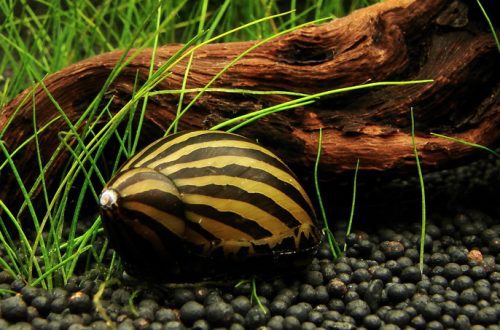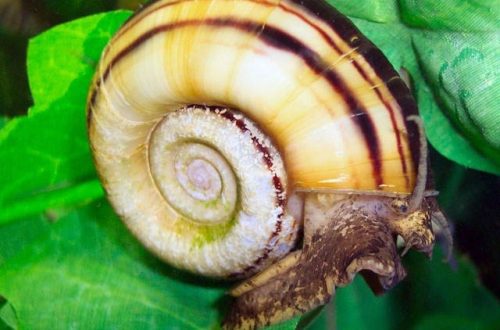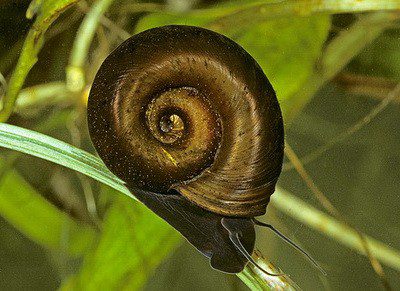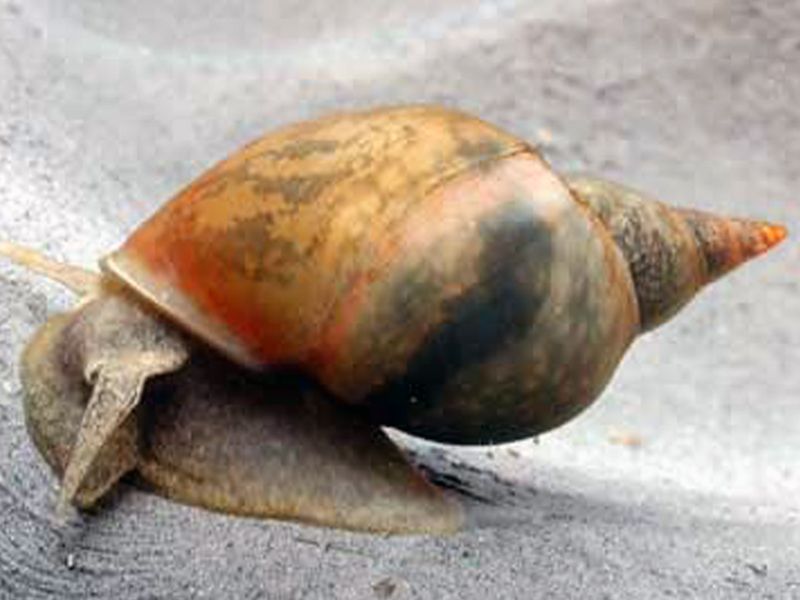
Physical: content, compatibility, reproduction, description, photo, video

The population of an aquarium is most often not limited to fish, frogs, dwarf crayfish or shrimps. In the neighborhood of these underwater inhabitants, snails almost always live. Their activity is an interesting subject to observe, and habits can affect the ecology of the entire aquarium. Let’s talk about the most popular genus of aquarium snails – Physa.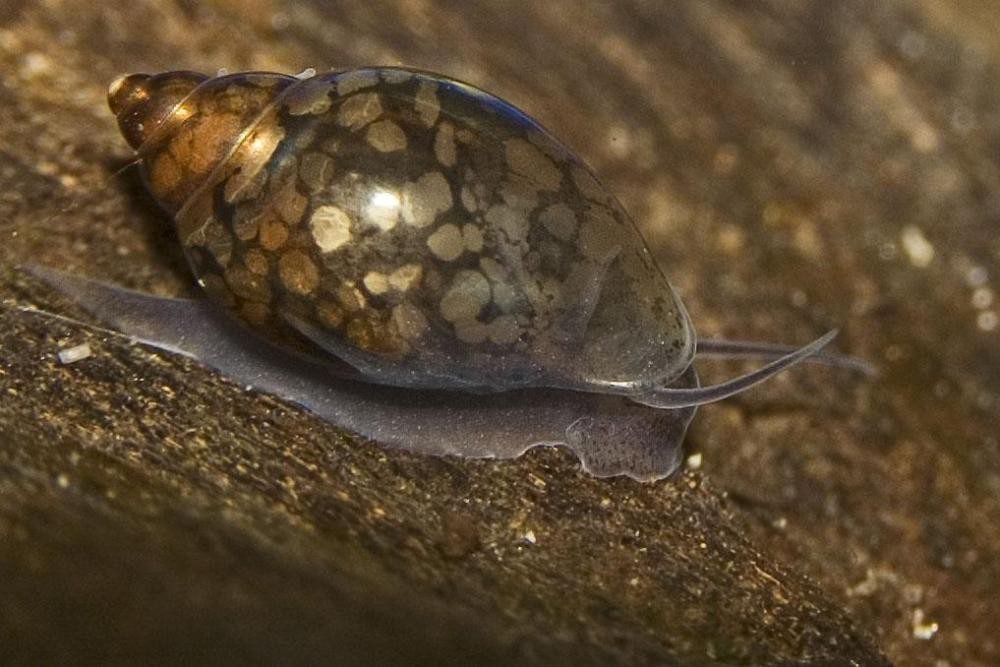
Contents
Types
In aquariums, two types of snails most often fall – bubble and pointed. In many ways, these species are similar. The shell of mollusks is twisted to the left and has an ovoid shape. They are hermaphrodites, and therefore breed very quickly.
- Physa pimply (Physa fontinalis). It reaches a size of 10, maximum 15 millimeters (but rarely grows more than 8-9 millimeters in an aquarium). The shell has 3-4 turns. Painted brown or yellowish brown. The body is blue-black.
- Physa pointed (Physa acuta). It is larger than vesicular (the maximum size is up to 17 millimeters). The shell has 5 whorls, sharpening at the apex. Its color varies from pink to brick or brown. The body is dark gray, with a golden speck, which beautifully shines through the shell.
Habitat
These are completely undemanding snails. However, this property can be considered a minus, because it is very difficult to withdraw them.
Required parameters:
- temperature from 20 degrees;
- moderate water hardness.
A distinctive feature of physical snails (especially young ones) is their ability to produce a thin sticky thread. An aquarium snail attaches it to various surfaces – stones, snags or plants, and leads to the surface, clinging to plant leaves or glass. The threads are so thin and transparent that it is extremely difficult to see them in the water.
Such tricks are necessary for rapid movement to the surface, since it breathes only atmospheric air. The threads keep for 15-20 days and can be used by whole flocks.
A remarkable feature of snails.
It lies in the fact that the physical body is capable of producing thin, but strong cobwebs – cords. Thus, she marks her habitat and increases her comfort of existence. Threads of mucus are a kind of stairs or an escalator for physio.
By secreting a sticky thread from its own body, the fiza attaches it to a pebble stone or to the bottom leaf of a plant. Then she slowly rises to the surface, stretching the cord behind her. And already at the surface it attaches the second end to the top leaf of the same plant. The snail then repeats this procedure several times. As a result, the little worker gets a strong and durable road for a quick descent and ascent.
I must say that just watching the construction of such a rope system is very interesting and informative! Children especially like it, helping them to better understand and love wildlife.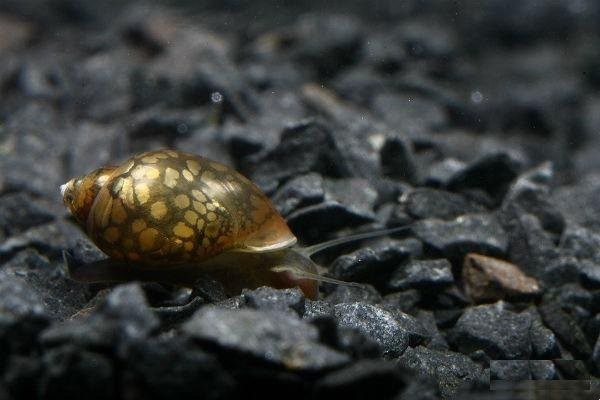
Content
Some aquarium lovers will tell you that Fiza snails are hardly desirable inhabitants of the underwater economy.
At first, they feed not only on decaying animal and plant remains, but are also very partial to algae, having tasted which, they always leave small holes.
Secondly, fiza is a hermaphrodite, and even being in a single copy in an aquarium, it easily reproduces, filling the space.
Thirdly, moving through the expanses of water, the phys can unwittingly destroy the fragile shell of the eggs, swept out by the fish living nearby.
But there are also positive features of the nature of these mollusks.
The life expectancy of a phys is 11-14 months. Young individuals are more mobile and are distinguished by the ability to create thin threads of mucus and stretch them from the bottom up, attaching the ends to the surface of the algae. On these ropes, which last up to 20 days, the physic moves to the surface of the water and back to saturate the body with air.
The mollusk reproduces by laying eggs on the leaves of algae (from 10 to 20 pieces at a time). After 2-4 weeks, several new snails come out of them.
In this case, you can call on the help of fish of the cichlid family, for example, Pseudotropheus Lombardo. They are able to eat adult snails. Catfish can destroy eggs and young individuals. Brocade glyptopericht or Ancistrus ordinary.
By their nature, snails of the genus Physa are unpretentious and do not require special care. With the right selection of aquarium inhabitants, they can become a real decoration of the reservoir!
Food
The phys snail is a rather gluttonous creature. She eats the remnants of food at the bottom, partially cleans off plaque on the glass. But even in the presence of food, the aquarium physiology is likely to want to feast on the plants in the aquarium. It causes serious damage to their decorative appearance by eating holes in the leaves.
Reproduction
How to withdraw
If the physes turned out to be uninvited and unwanted guests in the aquarium, it will not be easy to get rid of or reduce their numbers.
Possible ways:
- Reducing nutrition. It will not be possible to completely get rid of snails in this way, only to reduce their number. It is necessary to reduce the amount of fish food so that it does not settle to the bottom in the same quantities. But there is a high probability that the physicists will “revenge” and dine on aquarium plants.
- Neighborhood with predators. Due to its small size, the aquarium body is an ideal prey for fish. The most popular snail exterminators are cichlids, macropods, geophagus, dwarf tetradons. Ancistrus in the aquarium will help get rid of the caviar fiz. In addition to the fish, some crustaceans and molluscs will be happy to taste the fiz. The macrobrachium shrimp feeds on snails – it will quickly deal with the population. True, a lack of food can provoke an attack on some fish. Another option is the Helena snail. A bright and dangerous aquarium predator will deal a serious blow to the number of mollusks in the aquarium.
- Catching by hand. Manually removing all physical from the aquarium will not work. Very small individuals are almost invisible in the thickets, not to mention the caviar. But by regularly removing a few snails, you can successfully control their number.
- Chemical processing. Far from the best way to deal with snails. The main problem is a serious blow to the balance established in the aquarium. As a result, both fish and plants can suffer.

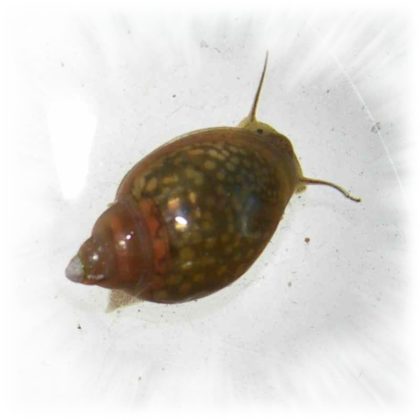
- Complete cleaning of the aquarium. We can say that this is a real aquarium general cleaning. To get rid of the physical and their eggs, the entire contents of the aquarium and the container itself are processed. Of course, this method is really reliable, but the complete treatment of the entire aquarium destroys the established biological balance, which in the end will have to be re-acquired.
Benefit or harm
As mentioned above, these snails are cleaners. They eat green plaque, destroy the remnants of food and dead plants. In general, they look pretty cute in aquarium conditions. Due to its unpretentiousness, the fiza is a great success with beginner aquarists.
On the other hand, the fiza snail is an eternal threat to plants. Even with enough food, she can taste algae on the tooth. If expensive or rare species of plants are planted in the aquarium, it is better to get rid of the snail.
It is strictly forbidden to run physical into aquariums with caviar. Crawling over the eggs and covering them with mucus, the snail destroys their protective shell. As a result, most of the eggs may simply die.
In general, it is impossible to give an unambiguous answer to the question of whether a snail is useful or harmful. With proper maintenance and population control, as well as careful care of the aquarium as a whole, the fisa can successfully live in the aquarium environment without causing unnecessary trouble.





